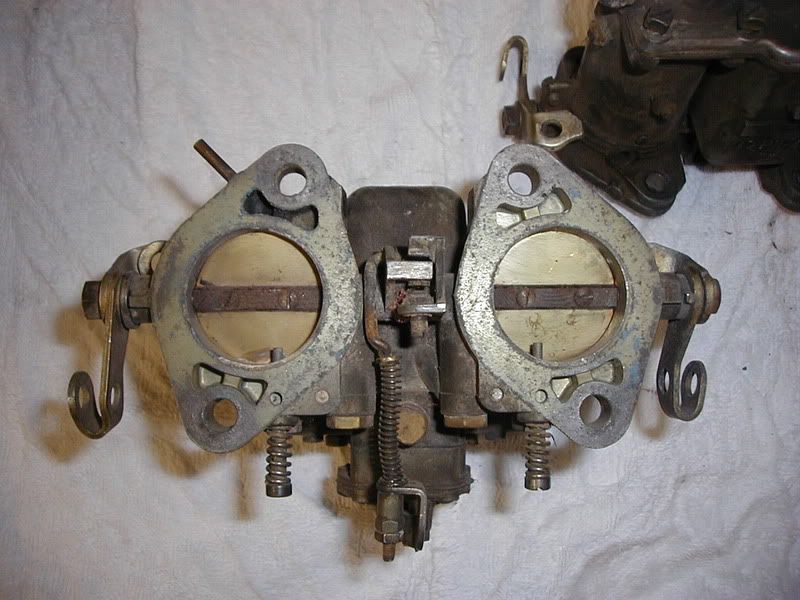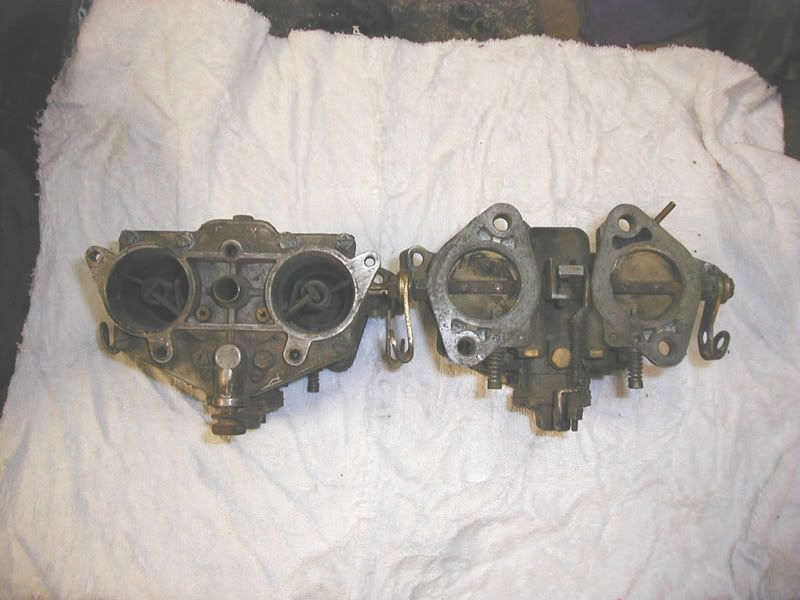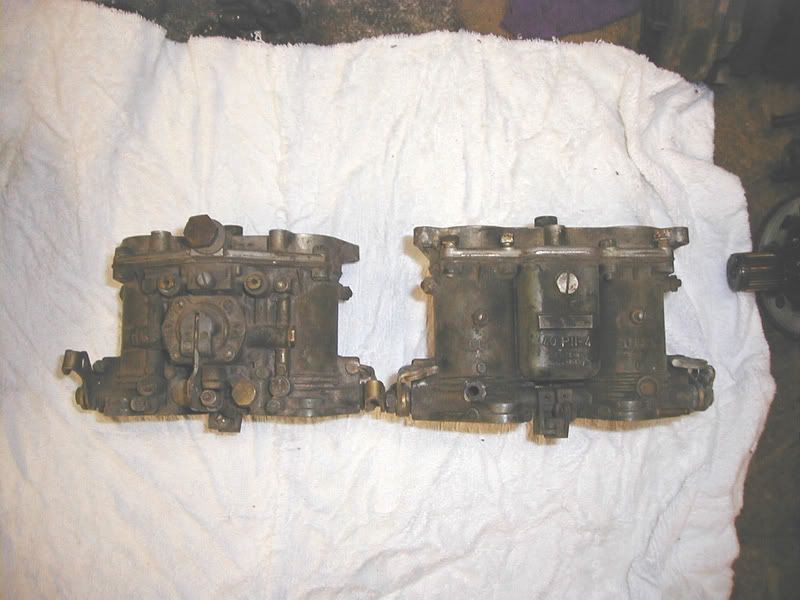Page 1 of 2
Solex 40 PII-4 Carburetors
Posted: Sun Aug 13, 2006 12:00 pm
by speedy57tub
For those using or thinking of using this carb, inspect the mating flanges for flatness. Mine on my 912 motor were tweaked and had lots of vacuum leaks. I simply applied dye chem and took out my quality long file and got to work. I used the thinnest gaskets with a slight film of hylomar and then fired up the engine....the result, as super smooth idle down at 800 RPM! Also, the engine responded extremely well to tuning. I hope this helps some of you.

Oh yeah, that "special" float adjustment tool and squirt measuring vial work great and are well worth the money.

Posted: Sun Aug 13, 2006 6:08 pm
by Rescue912
My absolute favorite carbs. Doesn't take much to tweak that bottom flange either. I always flatten them on a mirror with 320 grit wet/dry paper.
Posted: Sun Aug 13, 2006 7:56 pm
by speedy57tub
Rescue912 wrote:My absolute favorite carbs. Doesn't take much to tweak that bottom flange either. I always flatten them on a mirror with 320 grit wet/dry paper.
Yup...I was really surprised at what a difference it made once I worked on the flanges. I still need to play around with the jetting.

Currently I have 57.5 for idles and 122.5 for the mains. It is a 1720-cc with a mild cam (I do not know specs since I did not build it). I am in Vegas so usual "sea-level" jetting recommendations need to be adjusted. I am going to have to resort to checking the plugs and try to arrive to the best jetting.

Posted: Mon Aug 14, 2006 5:25 am
by Rescue912
The 122.5 may be just a little lean. Does it pop and crack a lot? With a big bore kit I usually start at a 125. Without knowing the cam specs and no AFR, checking plugs is your best best.
Posted: Mon Aug 14, 2006 6:27 am
by speedy57tub
Rescue912 wrote:The 122.5 may be just a little lean. Does it pop and crack a lot? With a big bore kit I usually start at a 125. Without knowing the cam specs and no AFR, checking plugs is your best best.
No popping or cracking.....I am going to check the plugs and then up the mains to 130 since I have a set of these.

I will then check the plugs again and take it from there.

Posted: Mon Dec 11, 2006 5:58 pm
by Ephry73
I want to know more about these carbs. A while ago I posted a question, and no one seem to like these. They seem to be cheaper to get than Webers, and look like smaller IDAs.
E
Posted: Tue Dec 12, 2006 7:21 am
by All_talk
I’ve got a set of these that came with a bunch of parts I bought. I cant answer any questions about running them cause I haven’t used them. But I could get you pics or take some measurements if that helps. And I might be looking to sell/trade them. I think Pillow in the Bus Barn knows something about them.
Gary
Posted: Tue Dec 12, 2006 9:33 am
by Ephry73
I wll be interested to run a set of these in a type 4 engine. From what I have read they work great when all of the issues have been ironed out.
After all, they were ran on the original 4 Cam engines.
Pics will be great, and do you know where the manifolds came from?
E
Posted: Tue Dec 12, 2006 11:09 am
by speedy57tub
These carburetors like high rev motors due to the 32-mm vents and its design in general. Webers (and Dells with their jetting) carbs fitted with 130 mains, 32 vents, 50-55 idles, F7 ET, and 180 AC mimic Solex carbs closely but use slightly more gas. The only drawbacks (apart from shaft wear on the earlier models, the flange surface bending problem and parts acquisition sourcing) for the Solex units is that changing out their jets is not as easy as the Weber/Dellorto IDF/DRLA carbs....the mains require dumping the fuel bowls.

Posted: Tue Dec 12, 2006 11:35 am
by Ephry73
Still sounds like a good carb for a high revving 1910 or 2200(66x103)
E
Posted: Tue Dec 12, 2006 1:00 pm
by speedy57tub
Ephry73 wrote:Still sounds like a good carb for a high revving 1910 or 2200(66x103)
E
Yup, I like them too but I did have to rebuild them (myself). I am very, very picky and I triple checked all of the nooks and crannies, tolerances, etc..... They do flow very nicely once all is said and done!


A nice revving 66-mm x stroke engine with the right headwork/valvetrain, cam, and exhaust would love them for sure!
Posted: Tue Dec 12, 2006 1:22 pm
by Ephry73
That's what I was thinking. I need to clean used carbs anyways, and I am too cheap to buy new kits. So since cleaning, rejetting and such is still needed, why not do it to those?
E
Posted: Tue Dec 12, 2006 3:45 pm
by speedy57tub
Ephry73 wrote:That's what I was thinking. I need to clean used carbs anyways, and I am too cheap to buy new kits. So since cleaning, rejetting and such is still needed, why not do it to those?
E
Ephry73,
I put a little grease on the perimeter of the shaft on the outside and then using compressed air I blow at the shaft from the inside of the bore to see if there are any leaks. If there is any seepage, the grease will let you know indicating that the throttle shaft is loose in that bore. Later split-shaft Solex carburetors are not too prone to this problem since they were redesigned with bushings. Over a decade ago I had my friend rebush a set of early solid-shaft Solex carburetors with bushings machined of an exotic teflon-impregnated brass material. Worked out great and the shafts sealed very well and moved very smoothly, although I recall having to spends some time to synch and balance the butterflies to each pair of barrels on each carburetor.

Posted: Tue Dec 12, 2006 10:15 pm
by All_talk
Heres a few pics of my carbs, they are the later split shaft style. As you can see there aren’t in super shape but certainly rebuildable, thy worst of it is some monkey bent up the shaft arms but even those are fixable. I don’t have any manifolds but understand the Web/Del manifolds can be redrilled to fit.
Here are some mounting dimensions (rounded to the nearest mm):
Center to center of the bores = 90mm
C to C of two hole pattern for each bore = 72mm
C to C of two top holes = 70mm
C to C of two bottom holes = 110mm



Gary
Posted: Thu Dec 14, 2006 8:28 am
by Porscheman912
the 40 p-II are to small for the 1911, but you can get the 40's open up to 44's. I have been tuning these car for awhile now, and they are good, and even the split shaft carbs having a wearing problem. The Zenith carbs are even starting to show wear and the base is made from cast. The Solex cards were factory installed on the Euro 914's. The base flange is different than webers or anything else. I know some people that are the best at remanufacturing solex and other carbs, and it is cheaper to get new webers do to the cost being about $1200 - $1500. I really like the solex's, they are very easy to tune, and the split shafts are pretty simple too. The solex does not have air by-pass screws like webers so the split shaft can be adjusted by the back butterfly. The big problem with split shaft is the rubber thing the used in the adjuster between them. Good luck guys.




